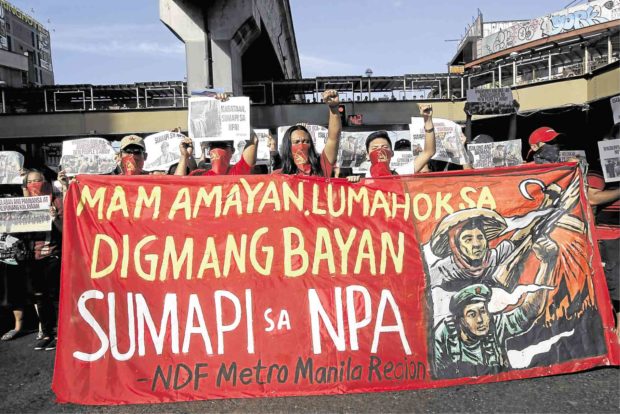
Communist rebels, like the ones who held a lightning rally in Quezon City in March, were among the targets for intelligence gathering by a network of village spies that police are building. —EARVIN PERIAS
SANTA ROSA CITY — Police in the region of Calabarzon (Cavite, Laguna, Batangas, Rizal and Quezon) are building a network of spies to target criminals, drug suspects and communist rebels, but composed of civilians with barely any formal training on intelligence gathering.
The Calabarzon police rolled out what it said was a community defense system that regional police officials said would not duplicate but “complement” the national government’s community-based program that sought to tap volunteers to serve as spies against crime suspects, drug traders, strangers in villages and rebels.
Dubbed “Community Mobilization Project (CMP)” the network has been compared to the anticommunist Alsa Masa movement in Davao City.
DILG project
Manuel Gotis, regional director of the Department of the Interior and Local Government (DILG), said the Calabarzon police’s CMP would complement the national government’s “Masa Masid (Mamamayang Ayaw sa Anomalya, Mamamayang Ayaw sa Ilegal na Droga)” project which taps volunteers to become government spies in the war on crimes, drugs and rebels.
Supt. Chitadel Gaoiran, Calabarzon police spokesperson, said CMP would strengthen the system of “information gathering” by police.
CMP had been launched separately in the region’s five provinces, the latest of which was on Sept. 5 in Quezon province.
Gotis said CMP would get its funds from an allocation of P500 million given to Masa Masid. CMP, said Gotis, “will not need additional funding.”
Chief Supt. Ma O Aplasca, Calabarzon police chief, said in an interview here that CMP sought to organize into “small clusters” from 10 to 20 households in every village to serve as an intelligence gathering network.
Espionage targets
Each cluster would select a leader who would transmit intelligence information to village chiefs or the local police for validation, Aplasca said.
He said the intelligence reports would be about suspected criminals, drug suspects, unfamiliar faces in neighborhoods or suspected rebels, which would be a focus in Quezon province where rebels continue to operate.
The CMP received the support of village chiefs in Calabarzon, one of the biggest regions in the country.
Lorenzo Zuñiga Jr., head of Laguna province’s League of Barangay Captains, likened it to Davao City’s Alsa Masa, an anti-communist movement that drove rebels out, but morphed into a vigilante group that had been accused of widespread human rights abuses against suspected communist supporters and sympathizers.
Aplasca said volunteers who would be tapped for CMP would not be armed.
Village clusters under CMP would be expected to submit recommendations on how best to gather intelligence reports like setting up security cameras.
Patriotism training
Aplasca said the ideal result of CMP would be the emergence of tightly-knit communities where neighbors watch each others’ backs, a Filipino character that Aplasca said seemed to had been lost over years of rapid urban growth.
The regional police chief said CMP would help assure crime witnesses of protection.
Since the launch of CMP, regional police had established 266 clusters (125 in Batangas province, and 141 in Rizal), according to regional police records.
Aplasca said volunteers were given training on patriotism, values formation and building stronger family ties.
Without saying where he got his data, Aplasca said 80-90 percent of criminals in Calabarzon “come from dysfunctional families.”
Even scalawags in the police force, he said, were “either separated (from spouses) or have multiple partners.”
CMP, said Aplasca, would help improve police response to crimes. Calabarzon has a population of over 14 million in 4,018 villages. Police-to-civilian ratio is currently one policeman per 1,200 people.